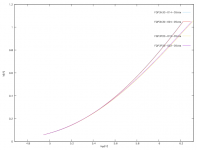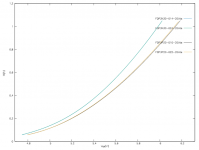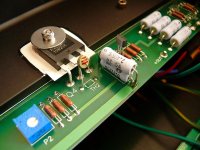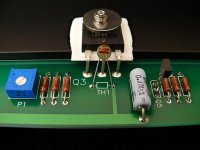No what happens is that the amp will work with almost any parts, within reason, but the resulting harmonics change. Better matched makes for an easier time of getting everything balanced and biased. Very bad matches may need changes to the associated resistors to get the DC state right, but the AC conditions will be such that more harmonic distortion is created. In some cases that does not sound "bad" at all. Depends.
So, the output fets must be matched? i think i read somewhere in the forum that the output fets doesn't need to be. I only have input fets matched from diyaudio store.
The best output FETs were from Fairchild, as NP pointed out.
You can tweak output FET performance by paralleling in source resistors to adjust the value of one or the other (assuming you have something like the QuantAsylum FFT analyzer.)
The input JFETs need not be matched. Best performance is obtained with the high gm original parts, but I've built an F5 with bogus J74's and its measured performance was really pretty good. You can put a 100 ohm pot in parallel with one or the other of the source resistors and tweak until you reach a THD minima.
A word to the wise (or careful, as the case may be) the protection circuitry really shouldn't be left out.
I agree 100%
A word to the wise (or careful, as the case may be) the protection circuitry really shouldn't be left out.
Mr. Pass, just said the best he heard were the Toshibas...
http://www.diyaudio.com/forums/pass-labs/121228-f5-power-amplifier-304.html#post4786961
The version I heard that knocked my socks off did have the original Fairchilds... not sure if they can be had though. Nor the Toshibas for that matter.
http://www.diyaudio.com/forums/pass-labs/121228-f5-power-amplifier-304.html#post4786961
The version I heard that knocked my socks off did have the original Fairchilds... not sure if they can be had though. Nor the Toshibas for that matter.
Mr. Pass, just said the best he heard were the Toshibas...
http://www.diyaudio.com/forums/pass-labs/121228-f5-power-amplifier-304.html#post4786961
The version I heard that knocked my socks off did have the original Fairchilds... not sure if they can be had though. Nor the Toshibas for that matter.
My bad...the Fairchilds gm matched up better. I have maybe 10 prs left.
The Toshiba's have low Vgs(on)... more than 2 V lower than the IRF's... I have several hundred so will have to give it a shot. Toshibas are really outstanding, clearly won the output MOSFET shootout conducted by Nat Semi several years ago.
The Renesas (Hitachi) are in the same low Vgs camp, and have lower transconductance but they give you the finger when they get overheated instead of blowing up.
The thing was that afaik the Toshibas have identical P and Nch transfer curves.
Don't think the others quite do the same...
...but I heard that some folks thought that the Tosh's sounded "duller", less "dynamic" etc...
...I have not heard them in the F5 myself, but have a few sets of matched pairs that are intended to go into one, IF I ever get to build one!! <phew>
Don't think the others quite do the same...
...but I heard that some folks thought that the Tosh's sounded "duller", less "dynamic" etc...
...I have not heard them in the F5 myself, but have a few sets of matched pairs that are intended to go into one, IF I ever get to build one!! <phew>
I've had all 3 mosfets, Fairchild, IRF and Toshibas in my F5. In that order. I would say the Fairchild are the most raw and dynamic, the IRFs are a little softer and fuller but somehow also the most fatiguing and 2D and the toshibas are perhaps the most delicate and hi-fi and probably, the best. Only the Toshibas were matched, however. Currently running a dual pair of Toshibas in an F5 with 24V rails. It has it all...sweet highs and nice textured bass. Honestly, the difference between the mosfets was not a huge deal...increasing bias has a much greater effect.
May I ask why, amongst several First Watt amplifiers, the F5 is the only one which has protection circuitry?
Sent from my GT-I9100 using Tapatalk
Probably because the F5 was designed from the beginning to be a DIY effort...a amp to get people started building amps.
Also, if the output is shorted bad things can happen quick on a f5. That is primarily the function of the protection. It's a current limiter only. No DC protection. Theoretically if the amp never pushes over 5A (I believe that is the current limit) it shouldn't effect the circuit in any way. It's mostly to keep the amp from smoking if the outputs are shorted, it's not really speaker protection.
A lot of these have been covered in the F5X thread, and the F5 Headamp thread.
A simple circuit like the F5 using complementary devices depends on the complementary characteritics of the active devices for even harmonic cancellation to achieve low distortion. This is particularly the case if you are not using a fully differential circuit like the F5X.
As I have published over a number of threads, the only truely complementary power MOSFET pair in TO3 package is the 2SK1530/2J201. There is another pair in TO220 from a different Japanese manufacturer which is now totally obsolete. The next best pairs in TO220 are 2SK2013/2SJ313 (if you have lots to match from), and FQP3N30/FQP3P20. But the Fairchilds are much more Vds dependent. This is where the Toshibas truely excel. A bonus of this is of course much improved PSRR.
But using the Toshiba MOSFETs alone is of little use if your JFETs are not equally complementary. And the 2SK170/2SJ74 pair is anything but. You can compensate for this using the degenration trick on the 2SJ74, but this is an impossible task for the average builder who does not have 1000s of these JFETs to choose from.
Contrary to common belief, the 2SK389/2SJ109 are different from 2SK170/2SJ74 and are more complementary, especially if you bias them at around 4mA. The other truely complementary JFET pair is 2SK163/2SJ44, if you can still get them. They do have lower Yfs, so you want to use a lower bias to compensate for the gm loss in the F5 circuit.
The JFET Id does vary with Vds, but this can be improved a lot by cascoding, amongst others to improve PSRR.
As already mentioned, the current limiter is not true speaker protection and will not detect DC voltage at the output. We don't use them in the F5X. But then we have a proper protection circuit instead.
Patrick
PS All the devices mentioned above, though almost all obsolete, can still be had matched, for a premium.
A simple circuit like the F5 using complementary devices depends on the complementary characteritics of the active devices for even harmonic cancellation to achieve low distortion. This is particularly the case if you are not using a fully differential circuit like the F5X.
As I have published over a number of threads, the only truely complementary power MOSFET pair in TO3 package is the 2SK1530/2J201. There is another pair in TO220 from a different Japanese manufacturer which is now totally obsolete. The next best pairs in TO220 are 2SK2013/2SJ313 (if you have lots to match from), and FQP3N30/FQP3P20. But the Fairchilds are much more Vds dependent. This is where the Toshibas truely excel. A bonus of this is of course much improved PSRR.
But using the Toshiba MOSFETs alone is of little use if your JFETs are not equally complementary. And the 2SK170/2SJ74 pair is anything but. You can compensate for this using the degenration trick on the 2SJ74, but this is an impossible task for the average builder who does not have 1000s of these JFETs to choose from.
Contrary to common belief, the 2SK389/2SJ109 are different from 2SK170/2SJ74 and are more complementary, especially if you bias them at around 4mA. The other truely complementary JFET pair is 2SK163/2SJ44, if you can still get them. They do have lower Yfs, so you want to use a lower bias to compensate for the gm loss in the F5 circuit.
The JFET Id does vary with Vds, but this can be improved a lot by cascoding, amongst others to improve PSRR.
As already mentioned, the current limiter is not true speaker protection and will not detect DC voltage at the output. We don't use them in the F5X. But then we have a proper protection circuit instead.
Patrick
PS All the devices mentioned above, though almost all obsolete, can still be had matched, for a premium.
Last edited:
...but I heard that some folks thought that the Tosh's sounded "duller", less "dynamic" etc...
If you were praising their sound, you might translate that description into
"sweeter", "warmer midrange" etc...
Setting aside the actual merits of the parts, the lower Vgs translates into
less feedback, and takes some edge off the F5. I have some speakers that
appreciate that.
> the Fairchilds gm matched up better
If you were referring to the original FQA19N20C / FQA12P20 then I cannot disagree more.
This has been published before in 2008 although I cannot find the link off hand.
Regards,
Patrick
.
Hi Patrick,
original f5 have more gain on negative half wave, because j74 have more Yfs
then k170, same with output devices. (N is with more gain).
But is not enough, look at that pictures in attachment, P output is more
degenerated then N output.
Makes sense only if k170 is with much higher Idss then j74,
or asimetry is wanted/intended.
Attachments
- Home
- Amplifiers
- Pass Labs
- F5 power amplifier



